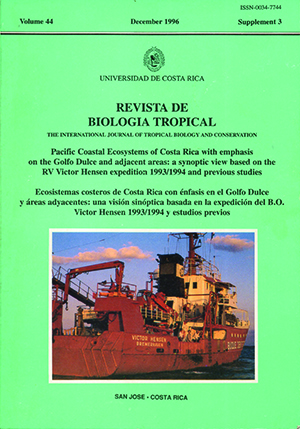Abstract
This study is based on a subset of plankton samples obtained during an expedition of the German RV Victor Hensen to the Pacific coast of Costa Rica in 1993/94. It aims at the identification of the main plankton taxa for a general description and comparison of the plankton communities of the gulf systems Golfo de Nicoya (GN) and Golfo Dulce (GO) and tile analysis of biomass spectra at inshore and offshore stations at the end of the rainy season and during the dry season. Inshore plankton biomass was significantly higher in GN than GO and exceeded offshore biomass several times, while in the GO area the reverse was found. In the rainy season, inshore biomass spectra of GN and GO were discontinuous with biomass concentrations at small sizes (around O.06mg) suggesting little developed communities. with highest production and energy use occurring in the small organisms. From the rainy to the dry season inshore species richness increased in both gulf systems and a shift was observed towards the larger size groups resulting in more continuous biomass spectra. In GN, bivalve larvae, foraminifers, ostracods, mysids and nauplii increase heavily in abundance and some gelatinous specimens occur. In GO. gelatinous zooplankton appears in enormous abundance and dominate the community biomass, followed by large chaetognaths and ostracods. In GO. inshore plankton has neritic and oceanic elements and differs less from the offshore plankton, whereas in GN, inshore plankton is largely neritic. The high abundance of fish eggs and invertebrate larvae suggest that this area is an important spawning ground. While in the rainy season inshore biomass was about 15 limes higher in GN compared to GO, this difference was reduced to 3-4 times in the dry season due to the appearance of the large predators mentioned above. The changes from the rainy to the dry season at the offshore stations of both gulf systems are less pronounced in terms of total biomass, shape of the biomass spectra and taxonomic composition of the community. The differences - relatively continuous biomass spectra with an increasing slope and a high total biomass in GD versus flat and sooner spectra due to the absence of large chaetognaths and medusa in the GN - suggest that conditions in the former area a!low for a better development of a trophodinamically tightly Structured plankton community.##plugins.facebook.comentarios##

This work is licensed under a Creative Commons Attribution 4.0 International License.
Copyright (c) 1996 Revista de Biología Tropical
Downloads
Download data is not yet available.


